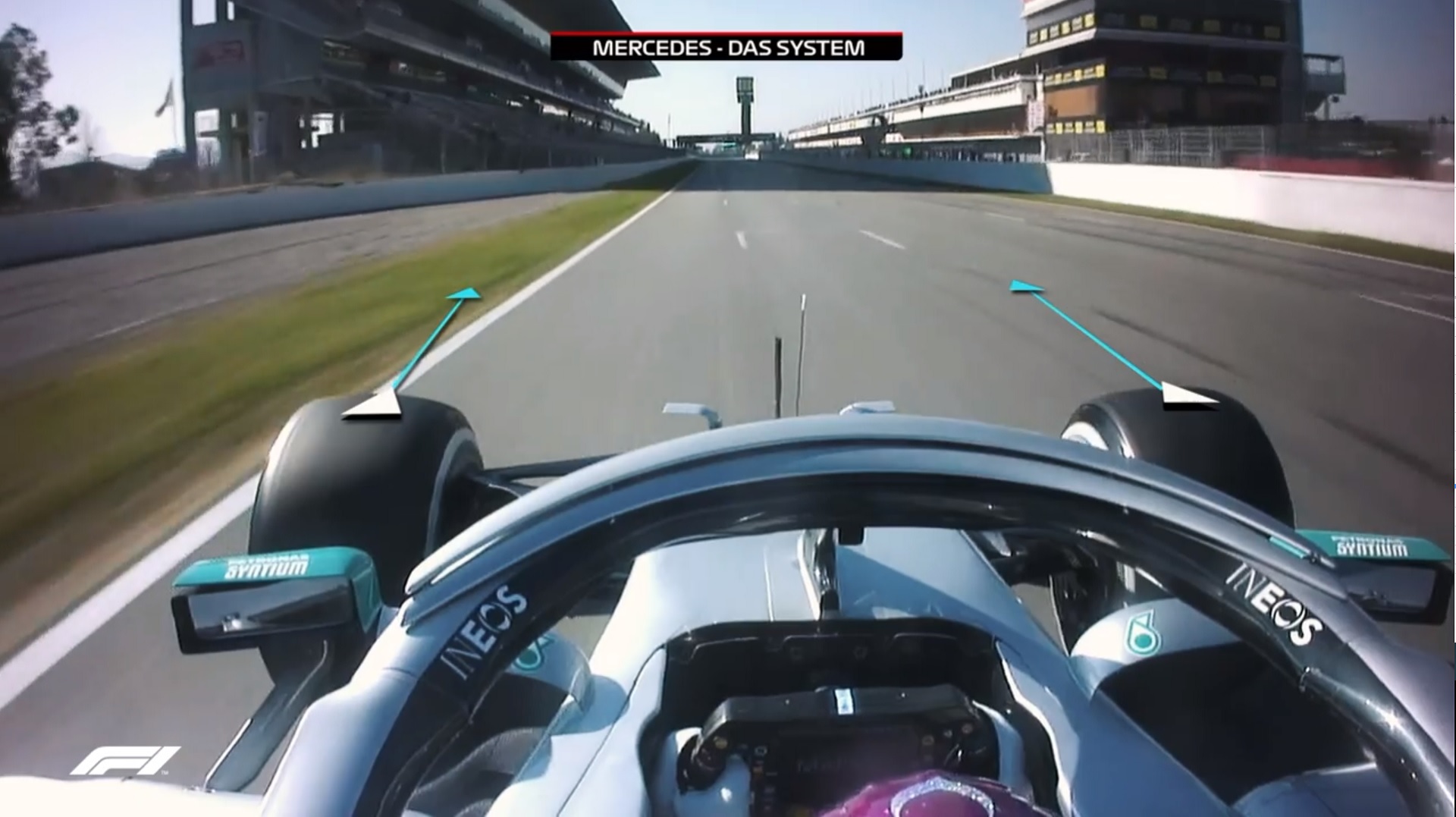

During the second day of Formula 1’s winter testing in Barcelona, engineers were spotted huddling around screens to watch footage of Lewis Hamilton doing something peculiar in his Mercedes-AMG W11.
In addition to turning his steering wheel like any normal car, the six-time F1 champion could be seen tugging the wheel toward him and pushing it away again along the straights. While that might sound like a mechanical issue, astute observers noticed that despite Hamilton keeping the steering straight, the front tires turned themselves ever so slightly toward or away from each other.
Soon after, we found out that it wasn’t a mechanical issue, but something Mercedes-AMG calls Dual Axis Steering, or DAS.
What you see Hamilton doing on that video is adjusting the car’s “toe”—the alignment setting for how many degrees left or right from the center a wheel points—on the front tires of his Mercedes while the car is moving. By pulling the wheel toward him on the straight, Hamilton reduces his W11’s toe-out, which is normally dialed in to trade mid-corner grip for turn-in grip. A reduced toe setting can reduce tire wear while also reducing rolling resistance, which also helps improve efficiency and top speed. Hamilton undoes the change before entering the corner by pushing the wheel back in again.
Why?
Why does Mercedes think it’s necessary to do this? While there’s no official word on what the team wants from DAS, it most likely has to do with being in control (much like everything else in F1). Being able to adjust the toe setting on the fly means a driver can remain in control of the handling characteristics of the car during the race. In our experience behind the wheel of non-F1 race cars, having the toe setting dialed in can help you waltz beautifully through the corners or make you look like it’s your first day behind the wheel of a car. It can hugely affect the car’s behavior because it dictates how the tires, chassis, and suspension will behave while the car is traveling in a straight line or while turning.
In testing, Hamilton seemed to only use the system toward the beginning of each run. Perhaps this means it’ll be employed to help with cold tires after a pit stop, though it could also come into play while trying to set the fastest lap of the race, or when degrading tires upset the driver’s idea of the optimum balance. For all we know, it could be a contingency that’s in place for an extremely specific scenario. On the other hand, if Mercedes finds it extremely useful in terms of performance—whether it be from a handling, tire, or time-savings perspective—it may become something as ordinary as pushing the drag reduction system (DRS) button every single lap.
It’s understood in the FIA Rulebook that alterations to a car’s suspension when in motion are considered illegal, although Mercedes-AMG exploits an important caveat—this specifically has to do with the W11’s steering system. Thus, regulations on steering systems are not nearly as tight and defined as those on suspension geometry as you can see in the following rulebook excerpts:


The governing body specifically mentions: systems that enable re-alignment of more than two wheels are not allowed—the Mercedes is only altering the toe of its front wheels.
FIA literature also explains that power-assisted steering systems must not serve any function aside from reducing physical effort while turning the wheel. In the case of DAS, however, it can be argued that the tool isn’t really powered at all. Instead, it seems to be controlled by the driver without the aid of electronics or even hydraulics, for if it utilized an assist from the latter, “the path would be shorter,” reckons Racing Point technical director Andy Green in an Auto Motor und Sport interview.
When confronted about what was going on in Hamilton’s car, Mercedes-AMG’s technical director James Allison didn’t play dumb. The team official stated that he’s confident the controversial piece of engineering is safe for his team’s drivers and more importantly, legal under F1’s rules.
“This isn’t news to the FIA, it’s something we’ve been talking to them [about] for some time,” Allison explained Thursday. “The rules are pretty clear about what’s permitted on steering systems and we’re pretty confident that it matches those requirements.”
An FIA spokesperson told RaceFans that they believe Mercedes’ DAS is indeed compliant with the rules, but that scrutineers won’t get to verify this until the Australian Grand Prix. A senior team official reportedly told SkySports—which has nicknamed DAS “trombone” steering—that the system isn’t test-only, implying it’ll be used for regular-season races. Racing Point’s Andy Green estimated in an AMuS report that it would take half a season to copy the advancement, and it might not even be worthwhile to attempt in fear of a prompt rulebook change or the system being incompatible with a team’s particular chassis.
Got a tip? Send us a note: tips@thedrive.com